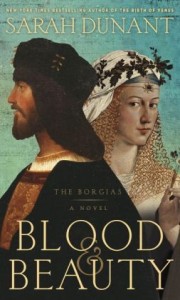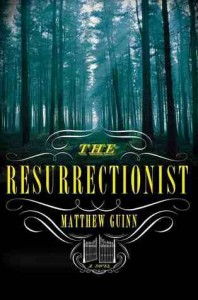'Bone Season', 'Gameboard', and More | Adult Books 4 Teens
Fiction
 BARLOW, Toby. Babayaga. 383p. Farrar. 2013. Tr $27. ISBN 978-0374107871.Adult/High School–Innocuous Will Van Wyck was working at an advertising agency in Paris in 1959 when his life lost its sanity. Will always knew, vaguely, that his ad agency was actually a front for the Agency, which has infiltrated all of Europe as part of its Cold War strategy. Then he meets Oliver Ames, archetype of the carefree American, who drops CIA connections, hidden guns, and other seeming non sequiturs into casual conversation. Poor Will is confused even before he meets Zoya, the gorgeous witch who steals his heart. Zoya has just left her married lover–left him impaled on an iron fence, in fact–a crime that has captured the attention of French Police Inspector Vidot. A tightly orchestrated chaos follows, while Barlow spins readers through both horrific, dark places and raw, magical love scenes. With the comic effect used so well by Terry Pratchett and Christopher Moore, Barlow laces fantasy and mystery into an unpredictable, highly imaginative story that treats a chicken with the same serious attention as a dangerous crone. The babayagas, witches of Old Russian folklore, have their say in free verse segments that punctuate the narrative. Those familiar with Barlow’s debut, Sharp Teeth (HarperCollins, 2008), will recognize the deep gravity the author infuses into his crazed plots. No one, even the smallest of fleas, remains unchanged in the end. Teen readers will find this a page-turner, as Barlow never allows the suspense to lag in any of the multiple story lines. Smart, sophisticated teens who gobble up Joe Hill or Neil Gaiman novels will enjoy Toby Barlow’s writing just as much.–Diane Colson, formerly at Palm Harbor Library, FL
BARLOW, Toby. Babayaga. 383p. Farrar. 2013. Tr $27. ISBN 978-0374107871.Adult/High School–Innocuous Will Van Wyck was working at an advertising agency in Paris in 1959 when his life lost its sanity. Will always knew, vaguely, that his ad agency was actually a front for the Agency, which has infiltrated all of Europe as part of its Cold War strategy. Then he meets Oliver Ames, archetype of the carefree American, who drops CIA connections, hidden guns, and other seeming non sequiturs into casual conversation. Poor Will is confused even before he meets Zoya, the gorgeous witch who steals his heart. Zoya has just left her married lover–left him impaled on an iron fence, in fact–a crime that has captured the attention of French Police Inspector Vidot. A tightly orchestrated chaos follows, while Barlow spins readers through both horrific, dark places and raw, magical love scenes. With the comic effect used so well by Terry Pratchett and Christopher Moore, Barlow laces fantasy and mystery into an unpredictable, highly imaginative story that treats a chicken with the same serious attention as a dangerous crone. The babayagas, witches of Old Russian folklore, have their say in free verse segments that punctuate the narrative. Those familiar with Barlow’s debut, Sharp Teeth (HarperCollins, 2008), will recognize the deep gravity the author infuses into his crazed plots. No one, even the smallest of fleas, remains unchanged in the end. Teen readers will find this a page-turner, as Barlow never allows the suspense to lag in any of the multiple story lines. Smart, sophisticated teens who gobble up Joe Hill or Neil Gaiman novels will enjoy Toby Barlow’s writing just as much.–Diane Colson, formerly at Palm Harbor Library, FL
BOHJALIAN, Chris. The Light in the Ruins. 320p. Doubleday. Jul. 2013. Tr $25.95. ISBN 9780385534819; ebook ISBN 9780385534826.
Adult/High School–Beautiful 18-year-old Cristina Rosati could not have foreseen a time when her perfect life as a nobleman’s daughter living in an opulent villa in the hills of Tuscany would end in bloodshed. In 1943, Nazis arrive at the villa, ostensibly to study the Etruscan tombs located on the property. To everyone’s chagrin, Cristina begins an ardent affair with one of the young Germans. Too soon, however, the Allied armies reach Italy, eventually clashing in a ferocious battle on the grounds of the Rosatis’ villa, leaving it in ruins. Flash forward to 1955, when the body of Cristina’s sister-in-law is found in Florence, with her heart carved out of her chest. Police investigator Serafina Bettina, a victim of war violence herself, suspects the motivation for the murder is rooted in the war years, possibly stemming from the Rosatis’ affiliation with the Nazis. When Cristina’s mother is murdered in the same fashion as her daughter-in-law, it becomes clear that someone is killing off members of the family, one by one. As Serafina searches for answers in the ruins of the villa, she uncovers painful memories of her own that may connect her to the Rosatis. Each revelation in pursuit of the killer seems to expose secrets buried in the violence of the past, raising questions of personal culpability during a time of war. Teens who love suspense will devour this one. Other subjects of interest in the book are the front-line view of invasion of Italy, and the Nazi’s systematic plundering of Florence’s treasures.–Diane Colson, formerly at Palm Harbor Library, FL
CLARK, Janice. The Rathbones. 384p. Doubleday. 2013. Tr $26.95. ISBN 9780385536936.
Adult/High School–The Rathbones have sailing in their blood. Fifteen-year-old Mercy knows this–she can sense creatures beneath the water and can tie knots better than a sailor. When a stranger appears and scares her, she and her uncle Mordecai must flee their ancestral home to the safer waters off the coast of Connecticut. As they travel, Mercy learns more about her strange and tightly woven family. Her great-great grandfather collected wives to supply his whaling ships with strong sailing sons–and that’s not the strangest familial twist in this gothic novel. Mercy’s story takes place in 1859, and she learns about her family’s history in chapters from those time periods in the early days of whaling. The beautifully designed novel combines the nautical details of Jack London’s The Sea-Wolf with the occasional perversion of a Flowers in the Attic-like twist (S & S, 2005). The romantic prose evokes the spirit of Moby-Dick and similar tales of epic journeys. Readers can smell the salt air and sense Mercy’s utter confusion as she unravels the secrets of her ancestors. Give this to teens who enjoyed the style of Rick Yancey’s The Monstrumologist (S & S, 2009) and who don’t mind oddities in their historical fiction.–Sarah Hill, Paris Cooperative High School, Paris, IL
 DUNANT, Sarah. Blood & Beauty: The Borgias. 528p. Random House. July 2013. Tr $27. ISBN 9781400069293; ebook ISBN 9780679603863.
DUNANT, Sarah. Blood & Beauty: The Borgias. 528p. Random House. July 2013. Tr $27. ISBN 9781400069293; ebook ISBN 9780679603863.
Adult/High School–It is 1492. New worlds are being explored. Great artists are creating masterpieces and science is exploding with new discoveries. It is a time of great change. Italy is a mixture of family run city-states with Rome in the center and Pope Alexander VI orchestrating the interplay among them. It is a world of violence, greed, war, and alliances built upon marriages made and dismantled, as well as payments received and “accidental” deaths incurred. Blood & Beauty opens as Cardinal Rodrigo Borgia ascends to the papacy as Alexander VI. He is not only the head of the Roman Catholic Church, but also of the large and ambitious Borgia family. His children, Cesare, Juan, Jofre, and Lucrezia, are young teens in a world in which their sole education is learning how to create power and wealth for the family through statecraft, guile, and warfare. Cesare, handsome and brave–cold as steel–is the family strategist and political power player who has no qualms in ridding himself of those who stand in the way of the family. Lucrezia’s role is to be beautiful and marry well. Her marriages are manipulated by Cesare and Alexander, who dispose of her husbands as they become obstacles, forcing Lucrezia to realize that family loyalty has its price and that maybe she, too, should step up and take charge of her own life. History-loving teens will find much to enjoy in this rich tapestry of renaissance Italy. The incongruity of a pope having not only a life-long mistress but also a large family gives a fascinating look into the dynamics of Catholicism in its time, and the impact that this larger-than-life family made on history.–Connie Williams, Petaluma High School, CA
EXTENCE, Gavin. The Universe Versus Alex Woods. 320p. Redhook: Hachette. 2013. Tr $25.99. ISBN 9780316246576.
Young Adult/High School–Mysteries usually end when the perpetrator is arrested, but Extence’s novel begins with the apprehension of Alex Woods, wanted for kidnapping, possession of marijuana, and suspicion of murder. The teen’s responses during interrogation are guileless statements of truth that are odd enough for readers to warily wonder what is wrong with this character and just where is this novel taking them. Then, Alex recounts the events leading to his arrest, beginning with his most distinctive experience: as a child, a meteor ripped through the roof of his home and struck him on head. Whether the meteor was the cause of his later epilepsy, his quirky personality, or his fascination with astronomy and love of lists is unclear, because his free-spirited mother also asserts an overbearing influence on him. By the time Alex, bullied by his peers and befuddled by adults, befriends cranky Viet Nam vet Mr. Peterson and learns to worship the novels of Kurt Vonnegut, readers will recognize that Alex exhibits some of the behaviors of Asperger’s. When Peterson enters the final stages of terminal cancer, Alex concocts a plan to assist with his suicide. His emotional detachment slowly withers as Alex navigates the emotions of loss, grief, and love. Inevitably, comparisons will be made with Mark Haddon’s The Curious Incident of the Dog in the Night-time (Doubleday, 2003), and teens who appreciate that novel, or the works of Kurt Vonnegut, will be fascinated with the extraordinary world of Alex Woods.–John Sexton, Greenburgh Public Library, NY
 GUINN, Matthew. The Resurrectionist. 288p. Norton. Jul. 2013. Tr $25.95. ISBN 9780393239317.
GUINN, Matthew. The Resurrectionist. 288p. Norton. Jul. 2013. Tr $25.95. ISBN 9780393239317.
Adult/High School–Jacob Thacker doesn’t want to work in public relations for his alma mater, the South Carolina Medical School, but his recent drug abuse means that he does what he’s told. When the skeletons of many dissected African Americans are found in a campus basement foundation, Jacob is charged with diffusing the situation, no matter the cost. In an alternate plot, Nemo Johnston, a slave owned by the college, is responsible for digging up cadavers for medical students to dissect, but he’s also an anatomy instructor and holds other authority not usually given to black men in the South in the 1860s. The two worlds collide when Jacob’s unearthing of the college’s secrets coincides with details from his own family’s past. Teen fans of mystery and crime novels will enjoy this fast-moving, behind-the-scenes look into the disturbing history of medical colleges of the South. The author includes a note describing the basis for Nemo Johnston, including works consulted. The grossness factor of dead bodies and dissection is similar to Daniel Kraus’s Rotters (Delacorte, 2011), while the handling of Southern racial issues reminds readers of Hillary Jordan’s Mudbound (Algonquin, 2008).–Sarah B. Hill, Paris Cooperative High School, IL
MEAD, Richelle. Gameboard of the Gods. 464p. (Age of X Series). Dutton. 2013. Tr $26.95. ISBN 978-0-525-95368-5. LC 2012050951.
Adult/High School–Mead’s futuristic science fiction novel takes place in the Republic of United North America (RUNA), where it has been determined that the three things deemed responsible for the earlier Decline–genetic manipulation, religion, and cultural separatism–should be outlawed or severely limited. Justin March is a former government employee, an investigator and licensor of religious groups who has been living in exile in the provinces. He is called back to RUNA to investigate a series of “closed-room” murders, and he soon discovers that all of the victims are 27 or 28 years old, genetically perfect, and from the pure-blood castes that were allowed to be “grandfathered” into society. Falling squarely into this profile is Mae, the praetorian who has been assigned to protect Justin, and the two of them must find out who is behind the murders before the next full moon. The action is fast and the characters are smart and funny, although information about what is really going on in the minds and lives of both Justin and Mae is revealed slowly throughout the book. Because it is closer to straight-up science fiction than Mead’s teen series, “Vampire Academy” and “Bloodlines” (both Penguin), it may not appeal to the same audience, but if you know teens who like science fiction with great characters, solid world-building, and just a hint of the supernatural, offer them this book; they’ll be waiting for the sequels.–Sarah Flowers, formerly at Santa Clara County Library, CA
MISHANI, D. A. The Missing File. tr. from Hebrew by Steve Cohen. 304p. HarperCollins/Harper. Apr. 2013. Tr $25.99. ISBN 9780062195371.
Adult/High School–In this debut, the first in a projected series, Mishani shows himself to be an apt pupil of detective fiction. The story opens with detective Avraham Avraham explaining to a mother that he knows her missing son will turn up for the same reason he knows why there are no detective novels in Hebrew: Israel simply doesn’t have the types of lurid crimes those novels feature. Needless to say, Avraham is soon proven wrong when Ofer never returns. Wracked by guilt, Avraham has difficulty concentrating on solving the crime rather than his own mistakes, especially as a pair of younger investigators are brought in on the case. Meanwhile, Mishani introduces readers to Ze’ev, Ofer’s neighbor and former tutor, who seems to know more than he should about the case, and is intent on weaseling himself into Avraham’s good graces. Mishani’s prose moves with the same contemplative yet steadily forward motion as Swedish crime novelists like Sjöwall and Wahlöö or Henning Mankell. And while Avraham does eventually solve the case of Ofer’s disappearance, his habit of watching old Law and Order episodes and reading Agatha Christie novels in order to prove the detectives’ solutions wrong should be a clue to readers that there is more to this mystery than meets the eye.–Mark Flowers, John F. Kennedy, Vallejo, CA
SCHINE, Cathleen. Fin & Lady. 272p. Sarah Crichton: Farrar. 2013. Tr $26. ISBN 9780374154905.
Adult/High School–Fin, 11, is orphaned after the death of his mother. In swoops Lady, his beautiful half sister who, as his new guardian, vows to take care of him. Thirteen years his senior, she, too, is an orphan. So begins their unusual life together in 1964 New York City. Lady is full of contradictions, at times tender and solicitous, at times inattentive and selfish. In spite of her flaws, Fin loves her fiercely and is often placed in the role of her protector. She is surrounded by suitors, but Lady’s dissatisfaction with her life is vividly drawn and unfolds within the context of the turmoil of the 1960s. A unique and effective means to learn more about the characters is woven throughout via the books they read and share. Lady disappears on her 28th birthday, leaving Fin feeling betrayed and angry. When she sends for him, she is living on Capri and has fallen madly in love. Thus begins another chapter in their relationship wherein Fin recognizes that for so long Lady had to work hard to live unfettered. She is now radiant and calm and pregnant. However, her notion of her future with her lover is not to be and, in a sad twist, Fin, now 18, becomes his young niece’s guardian. Teens will easily be transported to another time and place via memorable characters and narrative details. Schine’s droll humor will keep readers laughing out loud, and they will be enchanted by this well-crafted novel while pondering the question of what it means to be a family.–Jane Ritter, Mill Valley School District, CA
 SHANNON, Samantha. The Bone Season. 384p. Bloomsbury. Aug. 2013. Tr $24. ISBN 9781620401392; ebook $15.99. ISBN 9781620401408.
SHANNON, Samantha. The Bone Season. 384p. Bloomsbury. Aug. 2013. Tr $24. ISBN 9781620401392; ebook $15.99. ISBN 9781620401408.
Adult/High School–In 1859 at a séance, the border between this world and that of the Rephaim was somehow breached. Two hundred years later, several world cities are governed by the Scion Corporation–not strictly a dystopia, but a controlled situation in which people have their place and anything or anyone different, especially “voyants”–those with psychic abilities–is persecuted. Paige is one of those voyants, a dreamwalker who works for one of London’s top crime syndicates; one day, while going off to meet her Scion-employed father, she kills a man hunting for voyants and seriously injures another. Soon she is captured and lands in Sheol I, a prison city that encompasses Oxford. Slowly she realizes that there’s a special role for her in the upcoming bicentennial of the Rephaim’s arrival in our world, and revolt (or escape) becomes imperative. Luckily for Paige, she has friends in unexpected places. For readers intimidated by picking up the first of a seven-volume series, the ending is relatively satisfying. But for those willing to take the plunge, the series may well be the Next Big Thing, with action, romance and just enough paranormal to fill the void left by the conclusion of the “Twilight” and “Hunger Games” series.–Laura Pearle, Miss Porter’s School, Farmington, CT
SLOUKA, Mark. Brewster. 256p. Norton. Aug. 2013. Tr $25.95. ISBN 9780393239751.
Adult/High School–Jon Mosher lives in a rural New York town in which racism and bigotry are alive and well, and whose young men are dying in Vietnam. His parents are German Jews who barely escaped the concentration camps. His kindly father works hard in his shoe store on Main Street, but the family still grieves the early death of Jon’s older brother. His mother unfortunately and inexplicably blames Jon for the accident. When Jon is lured onto the track team by an observant teacher, he finds escape in long, punishing runs. A serious student and a bit of a loner, he develops an unlikely friendship with Ray, who is erratic, charming, and always getting into fights. As cold and uncomfortable as Jon’s home life is, it’s nothing compared with Ray’s. Ray must cope with a violent and alcoholic ex-cop father and protect his baby brother. When Karen, an attractive and energetic new student arrives in Brewster, Ray and Jon both fall in love, but once she meets Ray, there’s no question who she will choose. They talk constantly of moving to California, away from the constant rain and snow and ice. But amid the innocent dreaming, there is something menacing emerging in Ray’s life. Together they plot a way to flee Brewster and escape Ray’s father. Slouka’s writing is glorious. Song lyrics integral to the late ‘60s/early ’70s are incorporated into the prose in a way that immerses readers in the time and place. For its combination of evocative writing, unique setting, sharp characterization, and nearly unbearable suspense, Brewster is most highly recommended.–Angela Carstensen, Convent of the Sacred Heart, New York City
Nonfiction
 BOOKER, Sheri. Nine Years Under: Coming of Age in an Inner-City Funeral Home. 261p. Gotham: Penguin. 2013. Tr $26. ISBN 978-1-592-40712-5. LC 2012049711.
BOOKER, Sheri. Nine Years Under: Coming of Age in an Inner-City Funeral Home. 261p. Gotham: Penguin. 2013. Tr $26. ISBN 978-1-592-40712-5. LC 2012049711.
Adult/High School–As happens for many teens, a connection at church offered Booker a summer job she didn’t even know she wanted–an evening receptionist at a funeral home in West Baltimore. All she was supposed to do was answer the phone and the door. No connection with the bodies. At first this was plentiful, relatively easy work but, as in many family businesses, “other duties as assigned” came up. She graduated to assisting in obituary writing, singing at funerals, and eventually trips to the basement where the embalming and dressing of corpses took place. In one particularly strong anecdote, Booker picks up a body and stops for lunch. The strengths of the book are these individual episodes, which deal with the nature of grief, the finances of the funeral industry, and the marginalized of the inner city (gang members and transsexuals both make more than a few appearances). This is the author’s first book, and in places her immaturity shows–from the overwritten first paragraph to transitions that don’t entirely work. But there is no doubting her interesting youth, and it’s this that will draw teens in.–Jamie Watson, Baltimore County Public Library, MD
BOWEN, James. A Street Cat Named Bob: And How He Saved My Life. 288p. glossary. Thomas Dunne: St. Martin’s. 2013. Tr $24.99. ISBN 9781250029461; ebook ISBN 9781250029478. LC 2013009948.
Adult/High School–Bowen is an Australian living in London. In and of itself, that is not interesting. His descent into addiction and homelessness is, but it’s not the focus of this book, either. It’s the entry of Bob, an injured street cat, into Bowen’s life that readers learn about–one of those man-meets-feline (or is it feline-meets-man?) love stories that warms the heart. When they meet, Bowen is trying to get his life together; he’s on methadone and he’s eking out a living busking around Covent Garden. The addition of Bob means that he has someone not only to care about, but also to care for, and the responsibility weighs heavily on him. His new friend also adds to Bowen’s income, as Bob wins the hearts of the Londoners passing by Bowen’s guitar case, now featuring a snoozing Bob in addition to his earnings. The courage he shows in getting his life together, moving from the streets and heroin to an apartment, going clean and caring for Bob, will impress readers. Those who loved John Grogan’s Marley and Me (2005), Tom Ryan’s Following Atticus (2012, both Morrow), or Peter Gethers’s The Cat Who Went to Paris (Ballantine, 1992) will enjoy reading about Bowen and Bob’s relationship, but they’ll also need several tissues while reading.–Laura Pearle, Miss Porter’s School, Farmington, CT
 HARDY, Ed & Joel Selvin. Wear Your Dreams: My Life in Tattoos. 304p. photos. reprods. St. Martin’s. Jun. 2013. Tr $26.99. ISBN 9781250008824. LC 2013003988.
HARDY, Ed & Joel Selvin. Wear Your Dreams: My Life in Tattoos. 304p. photos. reprods. St. Martin’s. Jun. 2013. Tr $26.99. ISBN 9781250008824. LC 2013003988.
Adult/High School–Trained at the San Francisco Art Institute, Hardy went into the little known (at the time) field of tattooing and became internationally known for his work. When he met fashion designer Christian Audigier, his designs went on perfume bottles, t-shirts, bags, and more, creating a multi-billion dollar empire. Teens will be fascinated by his story, which he tells in a breezy, scattered fashion, including tons of tidbits (sometimes buried too much in the scatter, but there nevertheless) to pique their interest: the Museum of Pathology in Japan, where more than 105 tattooed human skins have been preserved, the yakuza (gangster) culture of Japan, and the story of Sailor Jerry’s pet chimpanzee, who had AL tattooed on one side of his butt check and OHA on the other so that when he bent over and looked through this legs it said ALOHA. Beginning in 1960 and ending in 2008, the book includes plenty of rambling adventure and name dropping all over the map–literally and figuratively. Through it all, Hardy focuses on being an independent artist, taking risks and following where his heart and interests lead. While he acknowledges that he is an addict, and got sober in the early ‘80’s when he was at the height of his fame, he doesn’t spend a lot of time on the nitty gritty, making this a perfect choice for a fairly clean read about an underground topic.–Amy Cheney, Alameda County Library, Juvenile Hall, CA
SHEFFER, Susannah. Fighting for Their Lives: Inside the Experience of Capital Defense Attorneys. 218p. index. Vanderbilt Univ. Mar. 2013. Tr $59.95. ISBN 9780826519108; pap. $27.95. ISBN 9780826519115; ebook $19.99. ISBN 9780826519122.
Adult/High School–Sheffer spent a year interviewing 20 attorneys who have devoted much of their careers to defending men and women sentenced to the death penalty. their clients were misunderstood or maligned by laypeople who don’t understand why capital defendants deserve lawyers; friends and family; and even by fellow capital defenders. The service these men and women perform and the toll it takes on them was long overdue for investigation. Sheffer probed these attorneys on their motivations for entering their profession; how they do their work; the relationships they form; the impact their work has on them; and more. The portrait that emerges is of an incredibly noble group of lawyers, holding their clients’ lives in their hands, who almost always fail to save those lives. And the psychological toll this takes is tremendous: attorneys speak of panic attacks, crushing anxiety, and the heartbreaking sadness of watching men and women they have come to know closely being put to death again and again. Regardless of one’s personal views on the death penalty, it is impossible not to see the passion and commitment these attorneys bring to their work, or to be moved by the sadness at the heart of their work. This is a deep look into the heart of a profession like none other and may very well make readers reconsider what they want to do with their lives.–Mark Flowers, John F. Kennedy Library, Vallejo, CA
The job outlook in 2030: Librarians will be in demand
The job outlook in 2030: Librarians will be in demand
ALREADY A SUBSCRIBER? LOG IN
We are currently offering this content for free. Sign up now to activate your personal profile, where you can save articles for future viewing






Add Comment :-
Be the first reader to comment.
Comment Policy:
Comment should not be empty !!!